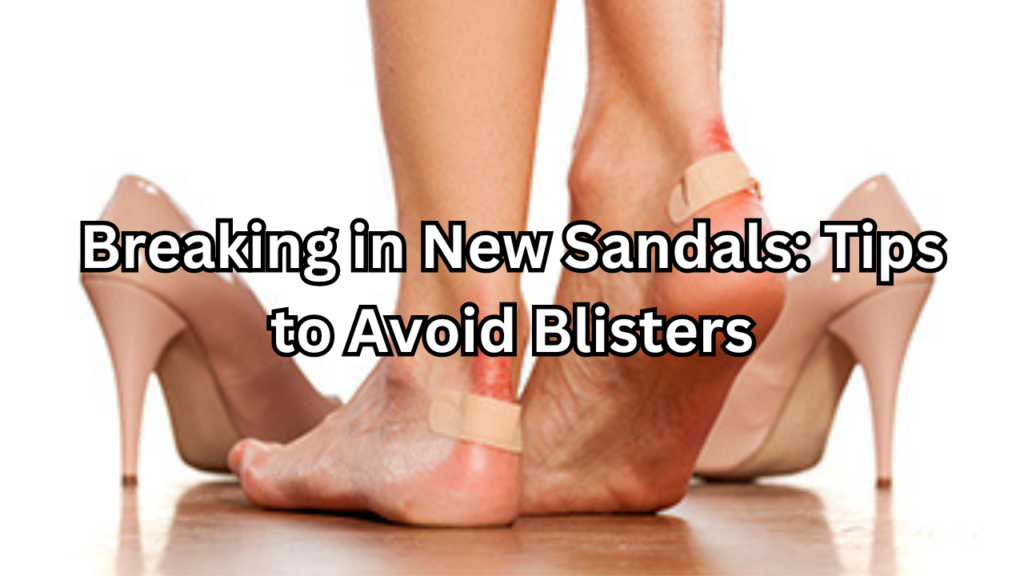

Table of Contents
Introduction
Breaking in new sandals can be an exciting yet challenging experience. While the promise of stylish and comfortable footwear is alluring, the reality often includes the uncomfortable prospect of blisters. These painful nuisances frequently arise from the friction and pressure that new sandals can place on your feet, particularly if they haven’t been properly broken in.
Understanding the importance of a proper break-in process is crucial for preventing these issues and ensuring a comfortable fit. By taking the right steps to break in your sandals, you can avoid unnecessary discomfort and enjoy your new footwear to its fullest potential. This article will provide practical tips and techniques to help you break in your sandals effectively and prevent those dreaded blisters.
Choose the Right Size and Fit
When it comes to avoiding blisters and ensuring maximum comfort, the most crucial step is choosing the right size and fit for your sandals. Proper sizing not only enhances comfort but also minimizes the risk of friction and pressure points that can lead to blisters.
Importance of Breaking in New Sandals
Wearing fashion sandals that are either too tight or too loose can significantly increase the likelihood of developing blisters. Sandals that are too tight create excess friction on the skin, while those that are too loose can cause your feet to slide around, leading to similar problems. Ensuring that your sandals fit properly is essential for both comfort and foot health.
How to Measure Your Feet for Sandals
To find your ideal sandal size, start by measuring your feet accurately. Here’s how:
- Measure Length: Place your foot on a piece of paper, and mark the longest part of your foot (typically from the heel to the tip of your longest toe). Measure the distance with a ruler.
- Measure Width: Measure the width at the widest part of your foot. This helps in finding sandals that accommodate the breadth of your foot.
- Try On Both Feet: Feet can vary slightly in size, so always try on both sandals to ensure a good fit.
It’s best to measure your feet at the end of the day when they are most likely to be slightly swollen, as this will give you a more accurate idea of how the sandals will fit throughout the day.
Choosing Sandals with Adjustable Straps or Features for a Custom Fit
Opting for sandals with adjustable straps or features can make a significant difference in achieving a custom fit. Adjustable straps allow you to fine-tune the fit of your sandals, accommodating various foot shapes and sizes. Look for sandals with:
- Velcro Straps: These offer flexibility and ease of adjustment.
- Buckles: Adjustable buckles provide a more secure fit and can be customized to suit different foot widths.
- Elastic Bands: These can offer a snug fit and adapt to your foot’s natural movement.
Choosing sandals with these adjustable features can help ensure that your sandals conform to your feet comfortably, reducing the risk of blisters and enhancing overall comfort.
Gradual Break-In Process
Breaking in new sandals properly is essential for ensuring comfort and preventing blisters. A gradual break-in process helps your feet adjust to the new footwear without causing unnecessary discomfort. Here’s how to approach this important step:
How to Start Wearing Your Sandals in Short Intervals
Begin by wearing your new sandals for short periods to allow your feet to get accustomed to them. Start with just 15-30 minutes at a time. This initial wear should be during activities that don’t put excessive strain on your feet, such as lounging at home or running light errands. The goal is to let your sandals gently conform to the shape of your feet without overwhelming them.
Increasing Wear Time Gradually to Build Comfort
Once your feet have adjusted to the initial short intervals, gradually increase the time you wear your sandals. Add an additional 15-30 minutes each day or every few days, depending on how comfortable you feel. For example:
- Week 1: Wear the sandals for 15-30 minutes daily.
- Week 2: Increase to 1-2 hours each day.
- Week 3 and Beyond: Gradually wear the sandals for longer periods as they become more comfortable.
This gradual approach allows your feet to build tolerance and helps the sandals to mold to your feet’s unique shape. If you experience any discomfort or rubbing, take a break and apply blister prevention measures, such as bandages or moleskin, to protect the affected areas.
By following a gradual break-in process, you’ll enhance the comfort of your new sandals and reduce the risk of blisters, ensuring that you can enjoy them to the fullest.
Use Protective Measures
Even with the best fit and a gradual break-in process, new sandals can still cause discomfort and blisters. To further protect your feet, employing various preventive measures can be highly effective. Here’s how to use protective measures to avoid blisters:
Applying Blister Prevention Tape or Moleskin
Blister prevention tape and moleskin are excellent tools for protecting areas of your feet that are prone to rubbing or pressure. Here’s how to use them:
- Identify Hot Spots: Before applying tape or moleskin, wear your sandals for a short time and identify any areas where friction occurs.
- Cut to Size: Cut the tape or moleskin into small pieces that will cover the hot spots. Ensure that the pieces are slightly larger than the area of concern.
- Apply Smoothly: Clean and dry your feet before applying the tape or moleskin. Stick it firmly to the skin, smoothing out any wrinkles to ensure it adheres well and stays in place.
These products create a protective barrier between your skin and the sandals, reducing friction and helping to prevent blisters from forming.
Using Blister Prevention Products Like Anti-Chafing Balms
Anti-chafing balms and blister prevention creams can also be highly effective in preventing friction and discomfort. Here’s how to use these products:
- Choose a Quality Product: Look for balms or creams specifically designed to prevent chafing and blisters. These products usually contain ingredients that reduce friction and create a smooth barrier on your skin.
- Apply Generously: Apply a thin, even layer of the balm or cream to areas prone to friction before putting on your sandals. Focus on spots where the sandals may rub, such as the heels, straps, and between the toes.
- Reapply as Needed: Depending on how long you wear your sandals, you may need to reapply the balm or cream throughout the day to maintain its effectiveness.
By incorporating these protective measures, you can significantly reduce the risk of blisters and make the break-in period for your new sandals more comfortable.
Moisturize and Care for Your Feet
Proper foot care is essential not only for breaking in new sandals but also for preventing friction and blisters. Keeping your feet hydrated and well-maintained can make a significant difference in your overall comfort.
Importance of Keeping Feet Hydrated to Prevent Friction
Hydrated skin is more elastic and less prone to irritation and friction. Dry, cracked skin can create areas where friction is more likely to cause blisters. Regular moisturizing helps to keep your feet smooth and supple, reducing the likelihood of friction and ensuring a more comfortable fit in your sandals.
Recommended Foot Creams and Lotions
To keep your feet in optimal condition, use foot creams and lotions that are designed to provide deep hydration. Look for products with ingredients such as:
- Urea: Helps to retain moisture and soften rough skin.
- Shea Butter: Provides rich, emollient hydration and helps to soothe and smooth the skin.
- Glycerin: Draws moisture into the skin and helps to keep it hydrated.
Apply a generous amount of foot cream or lotion before bed, and consider wearing cotton socks overnight to lock in the moisture and allow the product to fully absorb.
Stretching and Shaping Sandals
Breaking in sandals can sometimes involve more than just wearing them. Softening and stretching the material can help achieve a better fit and prevent discomfort.
Methods to Gently Stretch Sandals
- Using a Sandal Stretcher: A sandal stretcher is a tool designed to expand the material of your sandals gently. Insert the stretcher into your sandals and gradually adjust it to widen the fit. Leave it in place for 24-48 hours to allow the sandals to mold to your feet. This method is especially useful for leather sandals.
- Professional Stretching: If you prefer a more hands-off approach, many shoe repair shops offer professional stretching services. They use specialized equipment to stretch your sandals and can address specific problem areas for a more customized fit.
Techniques to Soften Stiff Areas
- Wearing with Thick Socks and Heating: To soften stiff areas, put on a pair of sandals. Use a hairdryer on a low setting to gently heat the stiff areas while wearing the sandals. The heat helps to make the material more pliable. After heating, continue wearing the sandals for a short time to help them mold to your feet.
- Using Leather Conditioner: For leather sandals, applying a leather conditioner can help soften the material and make it more flexible. Apply the conditioner according to the product instructions and allow it to absorb fully before wearing the sandals.
By combining proper foot care with techniques to stretch and soften your sandals, you can ensure a more comfortable fit and reduce the risk of blisters.
Pay Attention to Sandal Material
The material of your sandals plays a crucial role in how they break in and how comfortable they are to wear. Different materials respond differently to the break-in process and can affect the overall comfort and fit.
Differences in Materials (Leather vs. Synthetic) and Their Impact on Comfort
- Leather Sandals: Leather is a natural material that tends to mold to the shape of your feet over time, offering a custom fit. However, it can be stiff initially and may require more time to break in. Leather also benefits from conditioning, which helps to soften the material and enhance flexibility.
- Synthetic Sandals: Synthetic materials, such as faux leather or other man-made fabrics, usually require less break-in time compared to leather. They are often more flexible out of the box but can sometimes cause more friction or irritation if not properly adjusted. Synthetic materials are also generally easier to clean and maintain.
How to Handle Different Materials During the Break-In Process
- Leather Sandals: Start by wearing your leather sandals for short periods to allow them to gradually conform to your feet. Use a leather conditioner to soften the material and reduce stiffness. Avoid exposing leather to excessive moisture, which can damage the material.
- Synthetic Sandals: These can often be broken in more quickly. Wear them for short intervals and apply gentle heat if needed to help the material adjust. Ensure that any adjustable features are correctly set to avoid discomfort.
Inspect and Adjust Fit Regularly
Regular inspection and adjustment are key to ensuring continued comfort and preventing blisters as you break in your sandals.
How to Check for Any Signs of Discomfort or Pressure Points
- Inspect Your Feet: After wearing your sandals, check for any red marks, blisters, or areas of discomfort. These signs indicate where the sandals might be rubbing or causing pressure.
- Pay Attention to Fit: Assess how the sandals feel during wear. Are there any areas where the material seems to be pressing too hard? Are the straps or buckles digging into your skin?
Making Necessary Adjustments to Straps or Buckles
- Adjust Straps: If your sandals have adjustable straps, make sure they are neither too tight nor too loose. Loosen or tighten them as needed to find the most comfortable fit.
- Check Buckles: Ensure that buckles are positioned correctly and are not causing any pinching or discomfort. If necessary, adjust the placement or tension of the buckles.
Practical Tips for Daily Wear
To maximize comfort and minimize issues while wearing your sandals daily, consider the following practical tips:
Choosing Appropriate Socks or No-Show Liners if Applicable
- Socks with Sandals: If wearing socks with sandals, opt for thin, moisture-wicking socks that reduce friction without adding bulk.
- No-Show Liners: For a sock-free look, use no-show liners to protect your feet from direct contact with the sandal material. These liners help prevent blisters and absorb sweat.
How to Manage Different Terrains and Activities
- Terrain Considerations: Choose sandals that are suitable for the terrain you will be walking on. For example, sandals with better grip and support are essential for uneven or outdoor surfaces.
- Activity Management: If engaging in activities that involve a lot of movement or varying conditions, such as hiking or beach outings, select sandals designed for those activities to ensure proper support and comfort.
By paying attention to the material of your women sandals, regularly inspecting and adjusting the fit, and following practical tips for daily wear, you can enjoy your new sandals comfortably and without the hassle of blisters.
Conclusion
Breaking in new sandals may require a bit of patience, but the effort is well worth it for the comfort and enjoyment they can bring. By carefully choosing the right size and fit, gradually increasing wear time, and employing protective measures, you can effectively prevent blisters and discomfort. Remember to pay attention to the material of your sandals, regularly inspect and adjust the fit, and take practical steps for daily wear. Embracing a thoughtful break-in process ensures that your sandals will provide the best possible fit and support, allowing you to fully enjoy them without the hassle of painful blisters. Taking the time to properly break in your sandals not only enhances your immediate comfort but also contributes to a more enjoyable and long-lasting wearing experience.
Recap of Key Tips for Avoiding Blisters
Avoiding blisters while breaking in new sandals involves a combination of choosing the right size, gradually acclimating your feet, and using protective measures. Start by selecting sandals that fit well and offer adjustable features for a customized fit. Begin wearing them in short intervals and gradually increase the wear time to allow your feet to adapt. Employ blister prevention products, such as tape, moleskin, and anti-chafing balms, to protect sensitive areas and reduce friction. Additionally, maintain good foot care by keeping your feet moisturized and addressing any stiffness in the sandals with stretching techniques.
Encouragement to Take Time with the Breaking-In Process for Optimal Comfort
Breaking in new sandals is a process that requires patience and attention to detail. Rushing this process can lead to discomfort and blisters, detracting from the enjoyment of your new footwear. By taking the time to properly break in your sandals, you ensure that they conform to the unique shape of your feet and provide the best possible comfort. Remember, a well-broken-in sandal not only enhances your comfort but also prolongs the life of the footwear. Embrace the break-in period as an investment in your comfort and well-being, and you’ll enjoy your sandals to their fullest potential.





